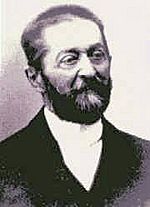Alphonse Beau de Rochas facts for kids
Quick facts for kids
Alphonse Eugène Beau de Rochas
|
|
|---|---|

Alphonse Beau de Rochas
|
|
| Born | 9 April 1815 Digne-les-Bains, Alpes-de-Haute-Provence
|
| Died | 27 March 1893 (aged 77) |
| Nationality | French |
| Occupation | Engineer |
| Known for | Four-stroke internal-combustion engine |
Alphonse Eugène Beau de Rochas (born 9 April 1815 in Digne-les-Bains, France – died 27 March 1893 in Vincennes, France) was a smart French engineer. He is best known for being the first to explain and patent the idea of the four-stroke engine in 1862. Even though he didn't build the engine himself, his ideas were very important. Other engineers, like Nicolaus Otto, later used his principles to create the engines we use today.
Contents
The Four-Stroke Engine Idea
Alphonse Beau de Rochas was a pioneer in understanding how to make engines more efficient. He figured out the best way for an engine to burn fuel and create power. This method is now known as the four-stroke cycle.
How the Four-Stroke Engine Works
The four-stroke engine is a type of internal-combustion engine. This means it burns fuel inside the engine to create movement. It works in four main steps, or "strokes," of a piston.
Stroke 1: Intake
First, the piston moves down inside a cylinder. This creates a space that pulls in a mix of air and fuel. Think of it like a syringe pulling in liquid.
Stroke 2: Compression
Next, the piston moves back up. It squeezes the air and fuel mixture into a very small space. This makes the mixture hot and ready to burn.
Stroke 3: Power
Then, a spark plug creates a spark. This spark ignites the squeezed fuel and air. The burning fuel creates a small explosion that pushes the piston down with great force. This is the stroke that creates power.
Stroke 4: Exhaust
Finally, the piston moves up again. This time, it pushes out all the burned gases from the cylinder. These gases go out through the exhaust pipe. After this, the cycle starts all over again.
Why Beau de Rochas's Idea Was Important
Before Beau de Rochas, people were trying to make engines work, but they weren't very efficient. He was the first to clearly describe the best way to do it. He explained that to get the most power from the fuel, you needed:
- To fill the cylinder as much as possible with the fuel-air mix.
- To squeeze the mix as much as possible before burning it.
- To expand the hot gases as much as possible after burning.
- To get rid of all the burned gases.
His patent detailed these four steps, which became the foundation for modern engines.
His Legacy
Even though Alphonse Beau de Rochas didn't build the first working four-stroke engine, his detailed explanation was crucial. His ideas were later put into practice by others, most notably by Nicolaus Otto. Otto built a successful four-stroke engine in 1876, which became widely used. Beau de Rochas's work showed the way for the development of engines that power cars, motorcycles, and many other machines we use every day. He was a true visionary in the field of engineering.
See also
 In Spanish: Alphonse Beau de Rochas para niños
In Spanish: Alphonse Beau de Rochas para niños

